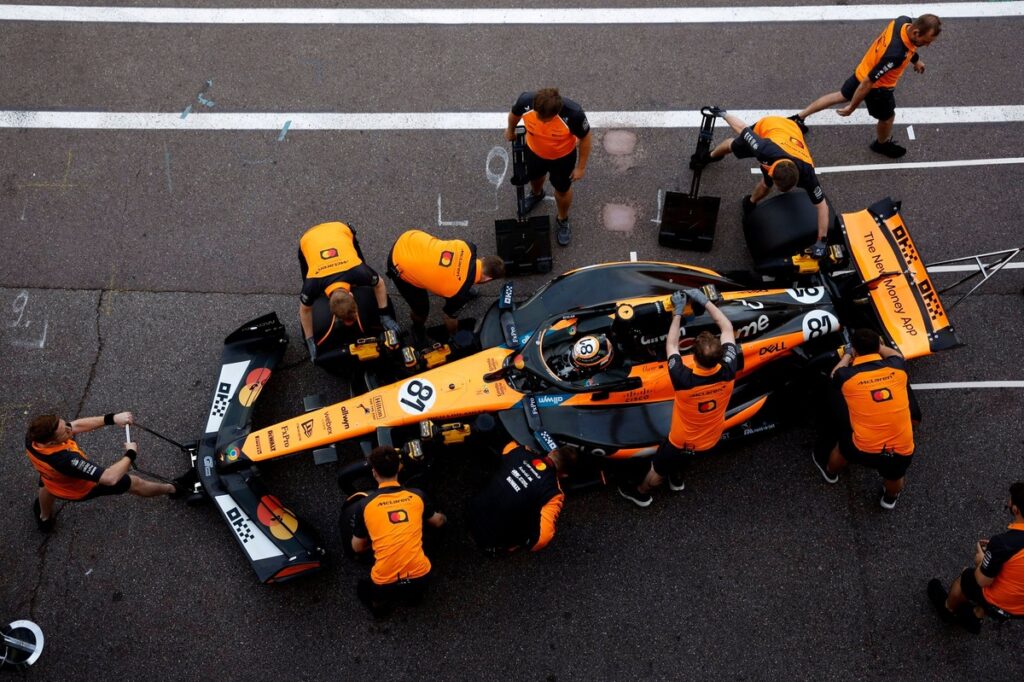Pirelli motorsport chief Mario Isola is concerned a long safety car period during the Formula 1 Monaco Grand Prix could lead to issues in the pitlane, suggesting it will take a “genius” rather than a strategist to work out how best to attack the race, now that using at least three tyres sets is mandatory.
F1 will enter the unknown when the lights go out on Sunday afternoon, with the decision to make each car theoretically stop twice during the race coming into effect for the first time in an attempt to bring more entertainment to the grand prix around the tight and twisty streets of Monte Carlo.
Some teams, particularly those with drivers further back down the field, could attempt what Haas’ Oliver Bearman labelled a “crazy” strategy.
To some degree, how teams cope with the Pirelli tyres on offer will dictate the approach, much like during a normal race weekend when only one stop is required. The new soft C6 compound is available for only the second time, having been debuted – and largely ignored – at the Emilia-Romagna Grand Prix a week ago.
Some drivers could run really long into the race on Sunday before pitting for the first time, while some have suggested stopping on lap 1 and lap 2 and then running until the chequered flag – although Isola is not expecting that to be the go-to plan for many.
“I heard some comments or questions about the possibility to have cars doing both stops at the beginning of the race. It’s not forbidden, obviously. So it’s something that any driver, any team could plan. But in my opinion it’s not really an option,” he said.
Mario Isola, Racing Manager, Pirelli Motorsport, on the grid
Photo by: Steven Tee / Motorsport Images
“Because here, safety car, virtual safety car and red flag are quite common. And if you use both the pitstops at the beginning and then you have a safety car, you damage your race, basically. Because you pay full time for the pitstop and you don’t get any advantage of a safety car or a virtual safety car.
“I know strategy engineers are working on all possible different strategies. I believe it’s interesting to see what’s the final decision for them. Something that is completely new. It’s new for us but it’s new also for them. And usually when we have something that is not under the control of the engineers, the race is better.
“With this new situation, it’s more difficult to predict because if a strategy engineer is able to predict all the unknown elements, he’s a genius, he’s not a strategy engineer. It’s very difficult, you have more elements that you should control.
“Also with one stop, like last year, there was a red flag on lap 1, everyone was on the same tyre, it’s not very difficult. Or you can have a safety car, or you can have another situation that is not expected, weather condition or whatever, but with this regulation it’s more difficult. We spoke to some teams, and they really – I don’t want to say ‘struggled to understand which is the right strategy’, because they will come with a solution, but there is a bit more uncertainty on the outcome of this.”

Red Bull Racing team members on the pit wall
Photo by: Sam Bloxham / Motorsport Images
While the mandatory two stops have been added to the regulations only at Monaco, where overtaking opportunities are at more of a premium than at any other race throughout the year, Isola admitted it would be interesting to see the rule implemented elsewhere, too.
“I would like to see the same situation at a normal circuit where it’s possible to overtake, in a more classic situation where maybe imposing the two mandatory stops can create a little bit of differentiation,” he said.
“It is true that in this case we don’t have the possibility to see a mix of strategies like [Charles] Leclerc last year in Monza, he won the race because despite everyone was on two stops, he decided to try to go to the end with the same set – or Russell in Spa… He wasn’t classified [having later been disqualified] but he was first under the chequered flag.
“So if the idea is to go to a mandatory stop, we lose a little bit of strategic variance, but on the other side it’s maybe more complicated for the strategy engineers.”
For Isola, there are also potential fears about safety in the pitlane. “I’m worried, to be honest – I’m worried only about one situation, that is a long safety car,” he said.
“Because a long safety car like Imola, eight laps, it means that everyone will come in [twice] in two laps. Because it makes sense. You use the opportunity of a long safety car, they have to repair barriers or move a car.
“You use this opportunity immediately. You don’t have any more obligation for the rest of the race. But the problem is that 20 cars in this pitlane are not really… I’m not sure that they have enough space.”
In this article
Mark Mann-Bryans
Formula 1
Be the first to know and subscribe for real-time news email updates on these topics
Subscribe to news alerts
Read the full article here

